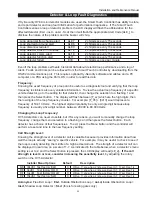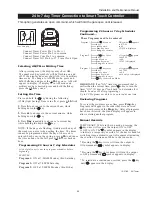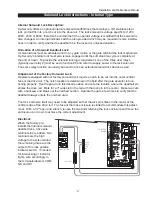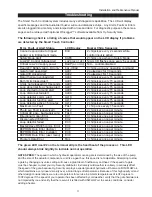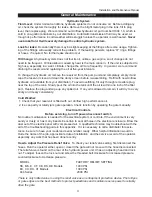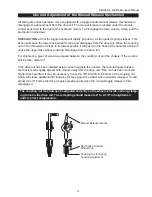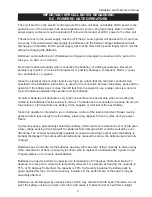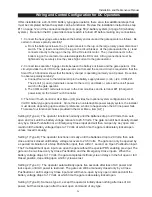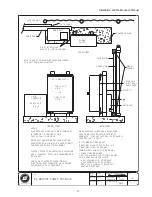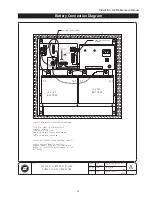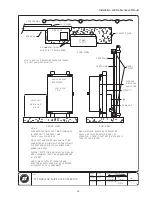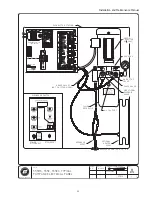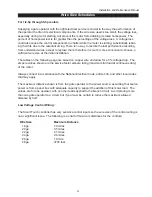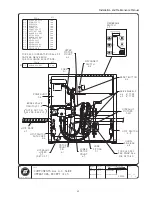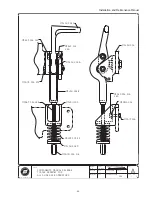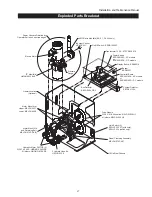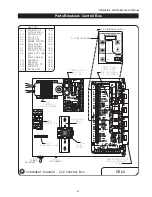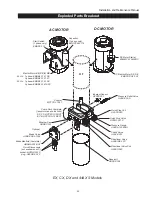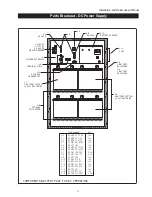
Installation and Maintenance Manual
56
Wiring and Control Configuration for DC Operators
If this installation is a 24-Volt DC battery type gate operator, there are a few additional steps that
must be completed before the system can be functional. Review the installation instructions, step
#11 on page 12 and the connection diagram on page 58 (2-battery system) or page 59 (4-battery
system). Be certain the DC power disconnect switch is turned off before making any connections.
1. Connect the heavy gage wires between the battery enclosure and the gate operator as follows: Be
certain to observe polarity carefully!
a. From the battery enclosure the (+) lead connects to the lug on the large rotary power disconnect
switch. The (-) lead connects to the lug on the circuit breaker. At the gate operator the (+) lead
connects directly to the lug on the top of the DC electric motor. The (-) lead connects to the
bottom lug on the contactor mounted alongside the DC motor. All lug connections must be
tightened very securely since they pass high current to the gate operator.
2. Connect two separate 14-gage circuits between the battery enclosure and the gate operator. One
circuit provides the 24 VDC to the gate operator controls and the second circuit is required so that the
Smart Touch Controller knows that the battery charger is operating normally on AC power. Be certain
to observe polarity carefully!
a. Connect four wires to the terminal strip in the battery supply labeled: (+)24, (-)24, COM, #21.
The 24 Volt (+) and (-) terminals connect to the red (+) and black (-) wires at the on/off power
switch in the gate operator.
b. The COM and #21 terminals connect to the Common Buss and to terminal #21 (Charger AC
power loss) on the Smart Touch Controller.
3. The Smart Touch Controller User Menu (U4) provides four optional system configurations for 24-
Volt DC battery type gate operators. Since this is an uninterruptible power supply system, the installer
must decide, depending upon customer preference, what is to happen when the AC line power fails.
There are four functional choices provided in the User Menu, item [AP_].
Setting 0 (Type A): The operator functions normally until the batteries drop to 20 Volts, then auto
open and lock until the battery voltage recovers to 23.5 Volts. The gate can still be manually closed
only by a Close Pushbutton or an Emergency Close input and will then re-open by any open com-
mand until the battery voltage drops to 17 Volts at which time the gate is absolutely locked open,
unless moved manually.
Setting 1 (Type B): The operator functions normally until the batteries drop to 20 Volts, then auto
close and lock closed until battery voltage recovers to 23.5 Volts. The gate can only be opened by
a special combination of a Stop Pushbutton input, then within 1 second, an Open Pushbutton input.
The Fire Department open input can open the gate without the special PBS enabling pre-input. The
gate can be re-closed only by Close Pushbutton and the Emergency Close inputs. When the
battery voltage drops to 17 Volts, the gate completes its final cycle and stays in the full open or full
closed position, depending upon which cycle was last.
Setting 2 (Type C): The operator automatically opens five seconds after loss of AC power and
locks open, until AC power is restored. The gate can still be manually closed only by a Close
Pushbutton or an Emergency Close input and will then re-open by any open command until the
battery voltage drops to 17 Volts at which time the gate is absolutely locked open.
Setting 3 (Type D): Same as type C, except the operator initially does nothing after loss of AC
power, but then locks open after the next open command of any type.

